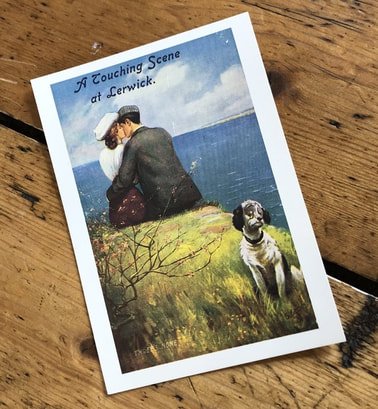Falling in love in Lerwick; a Shetland wedding
I've been a little preoccupied these last few weeks as we've been caught up in the midst of wedding madness. We got married last week, in a small ceremony in our back garden, here in Lerwick. The sun came out for the occasion and we had the most special day, together with family, celebrating. Our 'garden wedding', in the middle of town made me think of my favourite postcard from Lerwick (below) which shows a young couple, caught in a moment of passion, kissing on the 'banks broo', with the open sea in the background.
I always imagine that in their story, he is preparing to go back to sea, leaving her lovesick for months, with no more than a letter to remind her that he is thinking of her, and is safe. This is a story which is familiar to many people living in Shetland, both in the past and present day, although today we have the internet keeping people 'connected', and it is this 'touching scene at Lerwick' which gave me the inspiration for this latest blog post.
Despite our best efforts to slow down the hands of time and cherish every moment, the old clock keeps on ticking and time marches forward regardless. As our wedding guests left handwritten messages of congratulations on the toilet wall underneath the stairs, it got me thinking about the history of our house and the people who called it home before us.
Built in 1880 by a local merchant, throughout its life it has only had a handful of owners, most of whom were merchants here in Lerwick, and who have all left their mark in some way or another on various parts of the house and garden. I find these glimpses into the past fascinating, and I try to imagine the people who lived here before us. I think about whether they would like the changes we've made, the colours we've chosen and the lives we lead, and sometimes, I wonder if I am actually going insane?
Captain Johnson and his wife, previous owners of our house.
We have one or two photos of previous owners and have been able to patch together a little of the history. Treasured mementoes include a stamped address envelope from 1953 which a local surveyor found during an office clear-out and kindly gave us. We also have a handful of photos, including one from the late 1890s showing a couple standing in the doorway looking very poised and serious, I believe they were the original owners. These walls must hold many secrets and stories never to be unlocked, and I wish I could tell just one or two of them. Imagine being able to step out of the house and see Lerwick at its various stages of growth, as it developed into the town we know today, slowly encompassing the house which, when it was built stood on the boundary of Lerwick. Oh, if walls could talk!
One of the photos which came back from (the world's best) photographer, Alexa Fitzgibbon from our wedding day looked as though it could easily have been taken in 1890, not 2018. One of my favourites from the day, it was shot in black and white with nothing but the chimney pots in the background.
It transported my mind back in time and I wonder whether the owners of the house in 150 years will think about the past as we do? Will they consider, or even care who lived here? What will their thoughts be when they uncover photos and secret messages on the fabric of the building as we've done during the renovation? Will they cherish them as we do or simply plaster over the past? Has this digital revolution removed all future mystery from the equation? In the digital age of the future, will there still be unanswered questions or will the magic and wonder be removed by the simple click of a mouse?
We added to the story of our house when we married recently in the garden in Lerwick.
The history of our house and the history of the town made me think of and all the relationships which have been formed by people coming to live and work here in Lerwick. From the gutter women who followed the herring shoals north, and made their homes all along the towns North Road, to the incoming oil workers of the 1970s who came here when North Sea oil was discovered and the Sullom Voe Oil Terminal was built.
Shetland has long been a seafaring island and the diaspora is spread far and wide, reaching all corners of the globe, yet many still return in search of their ancestors and even today, people come to Shetland to plant new roots and call this island, their home. Perhaps the romantic pull is not from the past but rather from Shetland itself, from what the past can show us and what the future can offer us.
...and on that note, goodnight!





